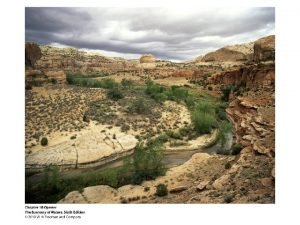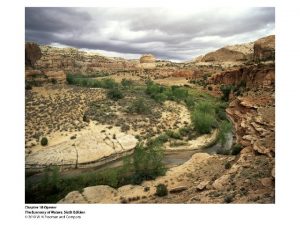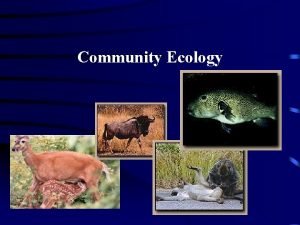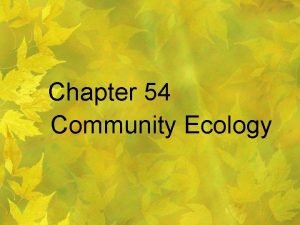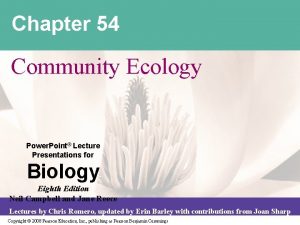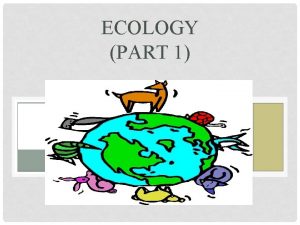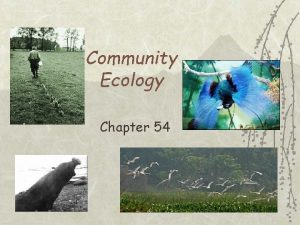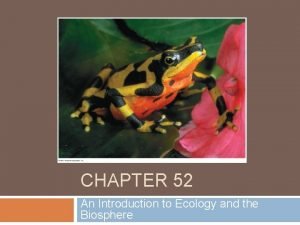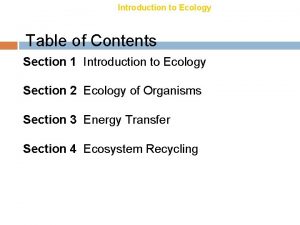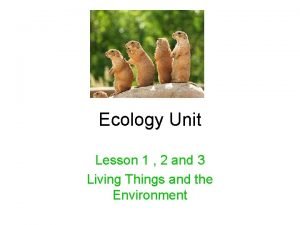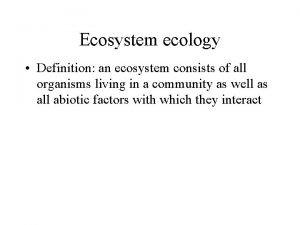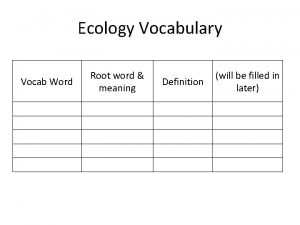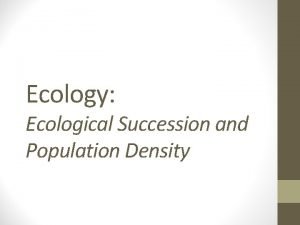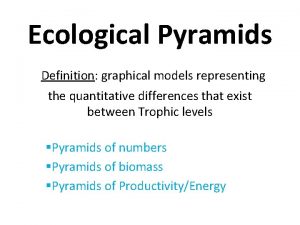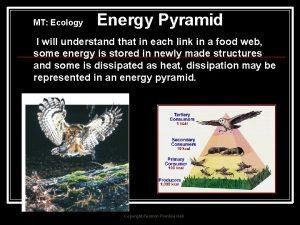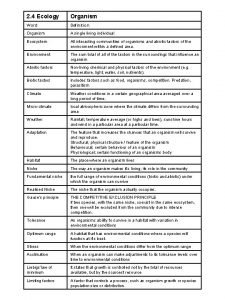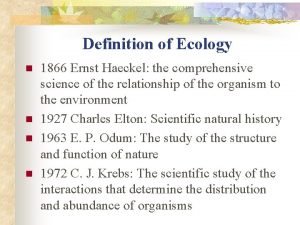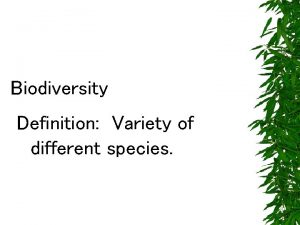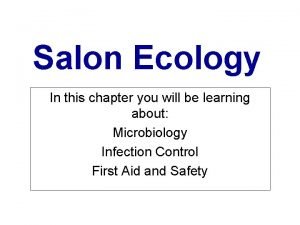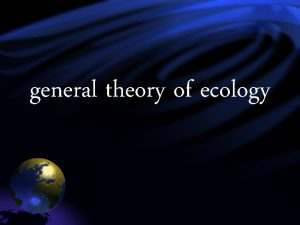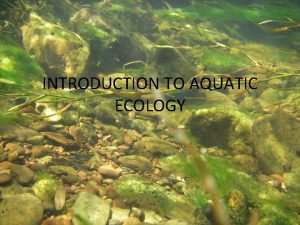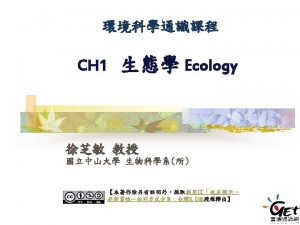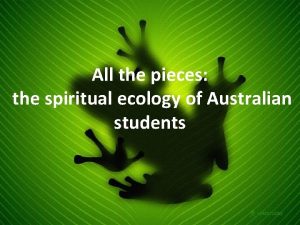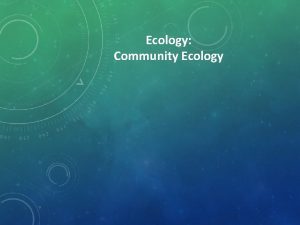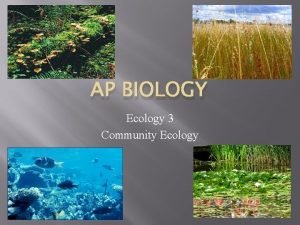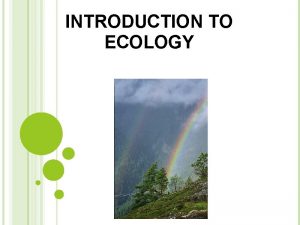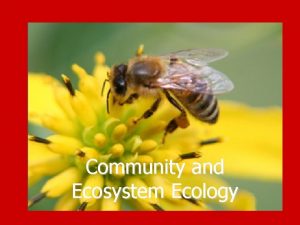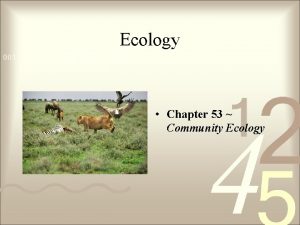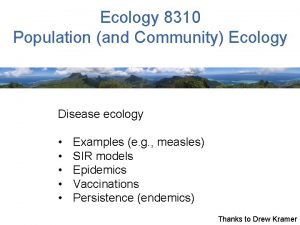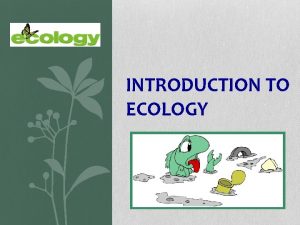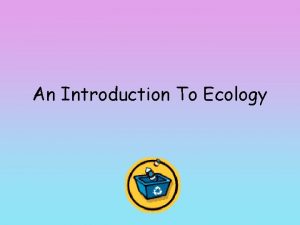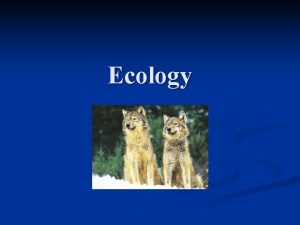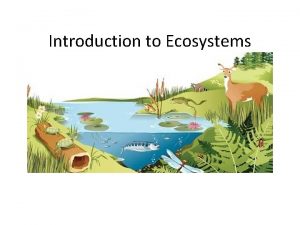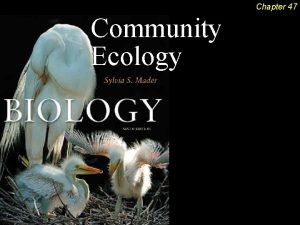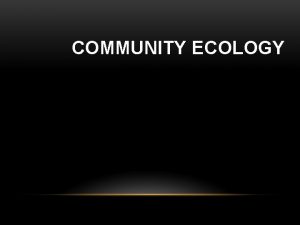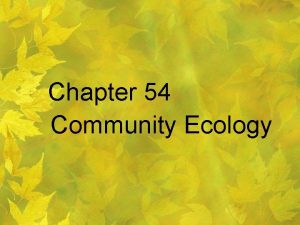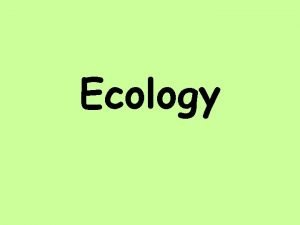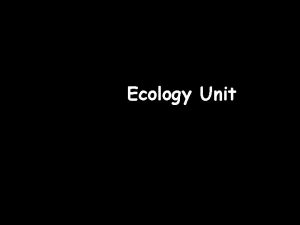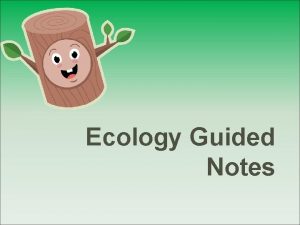Community Ecology Community Ecology I Introduction A Definition












































- Slides: 44


Community Ecology

Community Ecology I. Introduction A. Definition of Community a group of species interacting at the same place and time

I. Introduction A. Definitions B. Key Descriptors 1. Species Richness The number of species in a community Habitat 1 Habitat 2 species A 50 99 species B 50 1 Richness 2 2

I. Introduction A. Definitions B. Key Descriptors 1. Species Richness 2. Species Diversity Habitat 1 Habitat 2 - relative abundance - Diversity Indices Simpson’s = 1/Σ(pi)2 species A 50 (p = 0. 5) 99 (p = 0. 99) species B 50 (p = 0. 5) 1 (p = 0. 01) Richness 2 Simp. Div. 2 Simpsons: 1/ (0. 5)2 + (0. 5)2 1/(0. 25 + 0. 25) 1/0. 5 = 2. 0 2 1. 02 1/ (0. 99)2 + (0. 01)2 1/(0. 98 + 0. 0001) 1/0. 9801 = 1. 02

I. Introduction A. Definitions B. Key Descriptors 1. Species Richness 2. Species Diversity Habitat 1 Habitat 2 species A 50 99 species B 50 1 Richness 2 2 Simp. Div. 2 - relative abundance - Diversity Indices Simpson’s = 1/Σ(pi)2 3. Membership - species list Who are they? 1. 02

I. Introduction A. Definitions B. Key Descriptors 1. Species Richness 2. Species Diversity - relative abundance - Diversity Indices Simpson’s = 1/Σ(pi)2 3. Membership 4. Trophic Relationships Who eats who…

I. Introduction A. Definitions B. Key Descriptors 1. Species Richness 2. Species Diversity - relative abundance - Diversity Indices Simpson’s = 1/Σ(pi)2 3. Membership 4. Trophic Relationships Who eats who… Elton’s Trophic Pyramid

I. Introduction A. Definitions B. Key Descriptors 1. Species Richness 2. Species Diversity - relative abundance Lindeman’s Energetic Perspective: ENDOTHERMS (Warm Blooded – spend most energy on heat) Only 10% of the biomass consumed by herbivores is converted into herbivore biomass that is available to predators. - Diversity Indices Simpson’s = 1/Σ(pi)2 3. Membership 4. Trophic Relationships Only three trophic levels

I. Introduction A. Definitions B. Key Descriptors 1. Species Richness 2. Species Diversity - relative abundance - Diversity Indices ECTOTHERMS (Cold Blooded – don’t waste energy on heat generation) food chains can be longer, because energy is transfered more efficiently up a food chain (insects - 50% efficient). Simpson’s = 1/Σ(pi)2 3. Membership 4. Trophic Relationships Five levels, and more species

Lindeman - 40's - energetic perspective - energy available in lower level will determine the productivity of higher levels. . . this is called "bottom-up" regulation. not enough energy to support another trophic level

Hairston, Slobodkin, and Smith (HSS) - 1960 - Observation: "The world is green" - there is a surplus of vegetation

Hairston, Slobodkin, and Smith (HSS) - 1960 - Observation: "The world is green" - there is a surplus of vegetation - Implication: Herbivores are NOT limited by food. . . they must be limited by something else. . . predation? Predators keep herbivore populations low, which allows plants to thrive uneaten. “Top-down” regulation So, competition and predation are important determinants of community structure. How do they affect diversity?

Community Ecology I. Introduction II. The Effect of Competition and Predation on Diversity A. Competition 1. Between Two Organisms or Species: Competition costs both participants energy; it has negative effects on both.

A. Competition 1. Between Two Organisms or Species: - exploitative/scramble – organisms remove what they can; neither gets enough to maximize fitness

A. Competition 1. Between Two Organisms or Species: - exploitative/scramble – organisms remove what they can; neither gets enough to maximize fitness - territorial/contest/interference – competition for access to the resource, with ‘winner take all’. Winner still incurs cost of competition

A. Competition 1. Between Two Organisms or Species: 2. Among Multiple Organisms or Species: ADDITIVE: Species 1 loses to Species 2

A. Competition 1. Between Two Organisms or Species: 2. Among Multiple Organisms or Species: ADDITIVE: Species 1 loses to Species 2 Species 1 loses to Species 3

A. Competition 1. Between Two Organisms or Species: 2. Among Multiple Organisms or Species: ADDITIVE: Species 1 loses to Species 2 Species 1 loses to Species 3 Species 1 does even worse with both competitors present

Worthen and Moore (1991): Competition among Drosophila fruit flies D. falleni does poorly with D. putrida, and with D. tripunctata, and even worse when both competitors are present. ADDITIVE

A. Competition 1. Between Two Organisms or Species: 2. Among Multiple Organisms or Species: NON-ADDITIVE INDIRECT EFFECTS: Species 1 loses to Species 2 Species 1 loses to Species 3 Species 1 does better with both because they compete with one another and decrease their negative effects on species 1. “enemy of my enemy is my friend”

Worthen and Moore (1991): Competition among Drosophila fruit flies D. putrida is affected negatively by both competitors, but it does better with both together than with D. tripunctata, alone. NON-ADDITIVE INDIRECT EFFECT

A. Competition 1. Between Two Organisms or Species: 2. Among Multiple Organisms or Species: 3. Results of Competition: a. Competitive exclusion: reduction in growth, survival, and reproduction reduces the inferior competitor to zero over time.

A. Competition 1. Between Two Organisms or Species: 2. Among Multiple Organisms or Species: 3. Results of Competition: a. Competitive exclusion: reduction in growth, survival, and reproduction reduces the inferior competitor to zero over time. b. Resource Partitioning: both species evolve to reduce the competition by using other resources. RESOURCE (seed size)

Worthen (2009) 140 Mean Perch Height (cm) 120 Williams (1994) V-test, v = 0. 007, p < 0. 05 100 80 60 40 20 0 1 2 3 4 5 6

A. Competition 1. Between Two Organisms or Species: 2. Among Multiple Organisms or Species: 3. Results of Competition: a. Competitive exclusion: reduction in growth, survival, and reproduction reduces the inferior competitor to zero over time. b. Resource Partitioning: both species evolve to reduce the competition by using other resources. c. Character Displacement: Morphological adaptation to new resource during resource partitioning. Competition as an evolutionary force, selecting for the most efficient morphology on a new resource.

Community Ecology II. The Effect of Competition and Predation on Diversity A. Competition B. Predation 1. Predators reduce the population of their prey - if they are specialists, they will decline, too.

B. Predation 1. Predators reduce the population of their prey - if they are specialists, they will decline, too. - if they are generalists, they just switch to another more abundant prey Different species killed by mountain lions. Elk (russet), Mule deer (light blue), and white-tailed deer (grey) are about 55%.

B. Predation 1. Predators reduce the population of their prey - if they are specialists, they will decline, too. - if they are generalists, they just switch to another more abundant prey - introduced predators can wipe out prey species that are not adapted to them. Brown tree snakes on Guam Accidently introduced between 1946 -1953, probably as a stow-a-way on a ship. Reached peak densities of 100/ha (ha = ‘hectare’ = 100 m x 100 m. Basically, an average of one snake in every 10 m x 10 m square plot, across the entire island!!

9 bird species have been driven to local or global extinction on Guam, including the Guam Flycatcher (picture). Also, three fruit bat species have been decimated, affecting the plants they pollinate. This caused a reduction in vegetational diversity compared to neighboring islands that lack the snake. Those are some dramatic “top-down” effects on the whole community.

B. Predation 1. Predators reduce the population of their prey - if they are specialists, they will decline, too. - if they are generalists, they just switch to another more abundant prey - introduced predators can wipe out prey species that are not adapted to them. Sea Otter Hunting: Populations were overhunted, Dropping by over 95% Otter pelt sales in London (thousands) - removing a predator can “release” their prey, causing them to explode

Sea Otter Hunting: Otters eat sea urchins Without ‘top-down’ regulation, sea urchin populations exploded. Urchins eat kelp; and they grazed down the kelp forests off the coast of California, which are important nursery areas for commercially important fish species.

B. Predation C: Complex Dynamics in Communities 1. “Keystone Predator” Effects Arrows show energy flow; point to consumer.

WITH PREDATORS: No population can competitively exclude the others; all are maintained in a diverse community NO PREDATORS: Mussels are competitively dominant and they exclude the other species, resulting in a LOW DIVERSITY COMMUNITY

B. Predation C: Complex Dynamics in Communities 1. “Keystone Predator” Effects The top predator may keep the mesopredators in check, reducing their effects on the prey species. If the top predator is removed and the mesopredators increase, the prey may suffer MORE predation than when the top predator was present. mesopredators prey Top Predator

B. Predation C: Complex Dynamics in Communities 1. “Keystone Predator” Effects 2. Competition and Predation Change in Different Environments Dr. Jane Lubchenco (1978) Littorina littorea feeding on algae

- Snails prefer Enteromorpha to Chondrus - E is dominant in tide pools, - C is dominant on exposed rock

- Snails prefer Enteromorpha to Chondrus - E is dominant in tide pools, - C is dominant on exposed rock In pools, snails are feeding on the dominant and you get a keystone effect from low to intermediate snail densities; then they are so abundant they eat everything.

- Snails prefer Enteromorpha to Chondrus - E is dominant in tide pools, - C is dominant on exposed rock In pools, snails are feeding on the dominant and you get a keystone effect from low to intermediate snail densities; then they are so abundant they eat everything. On rock, snails feed on competitive subordinate and Enteromorpha is whacked by competition AND predation, and diversity declines with increase snail abundance. Effects depend on competitive dynamics, feeding preferences, and densities

- Snails prefer Enteromorpha to Chondrus - E is dominant in tide pools, - C is dominant on exposed rock In pools, snails are feeding on the dominant and you get a keystone effect from low to intermediate snail densities; then they are so abundant they eat everything. On rock, snails feed on competitive subordinate and Enteromorpha is whacked by competition AND predation, and diversity declines with increase snail abundance. Effects depend on competitive dynamics, feeding preferences, and densities

B. Predation C: Complex Dynamics in Communities 1. “Keystone Predator” Effects 2. Competition and Predation Change in Different Environments 3. Competing Predators can EAT One Another: Intraguild Predation

Intraguild Predation - eat your competitor! - get a meal and reduce competition! Wissinger, et al. 1993. Intraguild predation in larval dragonflies Tramea lacerata Erythemis simplicicollis Damselflies - prey

Intraguild Predation - get a meal! - reduce competition! Wissinger, et al. 1993. Intraguild predation in larval dragonflies Less mortality than expected with two predators Beneficial Effect on Prey as Predators Eat Each Other

What effect will an introduced species have on a community? What effect will the loss of a species have on a community? “The first rule of the tinkerer is to save all the pieces” – Aldo Leopold
 Definition of community ecology
Definition of community ecology Community definition ecology
Community definition ecology Ecology
Ecology Ecosystem vs community
Ecosystem vs community Community ecology
Community ecology Chapter 3 section 1: community ecology
Chapter 3 section 1: community ecology Chapter 54 community ecology
Chapter 54 community ecology Chapter 5 evolution and community ecology
Chapter 5 evolution and community ecology Biological disturbance
Biological disturbance Chapter 5 evolution and community ecology
Chapter 5 evolution and community ecology Chapter 5 evolution and community ecology answer key
Chapter 5 evolution and community ecology answer key Ecology examples
Ecology examples Level of ecosystem
Level of ecosystem Chapter 54 community ecology
Chapter 54 community ecology Chapter 52 an introduction to ecology and the biosphere
Chapter 52 an introduction to ecology and the biosphere Chapter 52 an introduction to ecology and the biosphere
Chapter 52 an introduction to ecology and the biosphere Section 18-1 introduction to ecology worksheet answers
Section 18-1 introduction to ecology worksheet answers Lesson 1: introduction to ecology answer key
Lesson 1: introduction to ecology answer key Clumped dispersion
Clumped dispersion Logistic and exponential growth
Logistic and exponential growth Ecosystem ecology definition
Ecosystem ecology definition Ecology root word
Ecology root word Autotroph
Autotroph Primary succession definition ecology
Primary succession definition ecology Detritivore definition ecology
Detritivore definition ecology Ecological pyramid definition
Ecological pyramid definition Ecology definition
Ecology definition Energy pyramid definition ecology
Energy pyramid definition ecology Definition of organism in ecology
Definition of organism in ecology Chemoautotrophs
Chemoautotrophs Ernst haeckel ecology
Ernst haeckel ecology Reconciliation ecology definition
Reconciliation ecology definition Microbial ecology definition
Microbial ecology definition Behavioral ecology definition
Behavioral ecology definition Salon ecology definition
Salon ecology definition Keystone species definition and example
Keystone species definition and example Odum definition of ecology
Odum definition of ecology Population definition ecology
Population definition ecology Aquatic ecology definition
Aquatic ecology definition Mutualism
Mutualism Ernst haeckel 1869
Ernst haeckel 1869 321 riq
321 riq Community action cycle for community mobilization
Community action cycle for community mobilization Introduction of community policing
Introduction of community policing Community pharmacy management
Community pharmacy management
